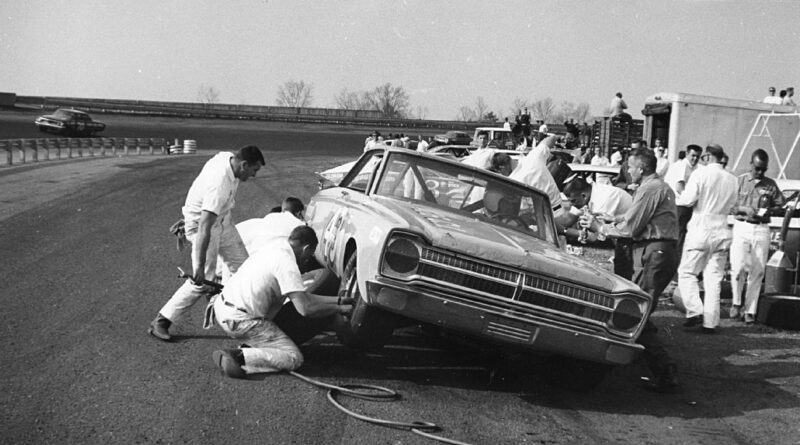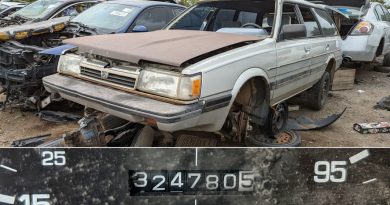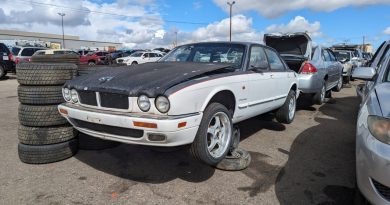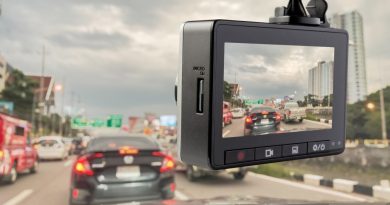North Wilkesboro’s petite pit lane shows how far crew safety has come
“What the hell …?”
The moving images from back in the day at North Wilkesboro Speedway, closed since 1996 but about to be improbably revived for Sunday’s NASCAR All-Star Race, are hard for any modern mind to process.
“Dude, they are going so freaking fast!”
But for this particular audience at this particular time, their disbelieving shakes of the head and open-mouth, squinting facial expressions are not in reaction to the grainy, square-boxed, standard-definition video or the massive, square-edged race car body styles. Not even the parade of logos and colors provided by sponsorship dollars from so many companies that no longer exist.
“Yeah, OK, look at that guy. Nope. Sorry, I ain’t doing that …”
These video viewers are modern-day pit crew members at Richard Childress Racing. They are young, finely tuned athletes, with stick-and-ball championship rings and other accolades earned in college sports stadiums and through countless hours spent in weight rooms and film rooms, perpetually seeking the perfect body and the perfect pit stop.
But now, here they sit, slack-jawed, watching their RCR predecessors, Dale Earnhardt’s “Flying Aces,” as they change four tires and fuel on the No. 3 GM Goodwrench — and before that, Wrangler Jeans — Chevy at the .625-mile North Wilkesboro bullring that will be resurrected this weekend, just in time to put today’s crew members, many of whom weren’t yet born the last time it hosted NASCAR‘s premier series, to work in that same space. Sort of.
“Yeah, I got to be honest with you, these are real men right here.”
1987 at @NWBSpeedway. No pit road speed limit. No pit wall. No crew helmets. I think I remember how crazy it was back in the day. But then you see this and, holy schnikes. Look how fast it is out the driver’s window of Neil Bonnett’s car at the 1:30 mark…in the pits! #NASCAR75 pic.twitter.com/vYeQFabijh
— Ryan McGee (@ESPNMcGee) May 15, 2023
“You don’t ever want to admit that you’d be scared, but man, there’s no way I’m doing this,” confesses Josh Sobecki, jackman for Kyle Busch‘s No. 8 RCR Chevy. He has been going over the wall since 2006, a decade after North Wilkesboro Speedway was shuttered. He is 37 years old, and throughout 18 years of carrying tires and slinging jacks, the Pittsburgh native has endured a torn meniscus, MRIs on both shoulders, a groin tear and so many back injuries and muscle pulls that he long ago lost count.
Dude is large. He is tough. But he isn’t crazy. What he just watched on his phone, that’s crazy.
“The closest thing that we ever had was several years ago we did pit stops for All-Star qualifying at Charlotte, the only time there’s been no pit road speed limits over the last 30 years,” Sobecki said. “They’d come down pit road and they’re downshifting, and my mind I’m like, there’s no way that I would jump out in front of this a dozen times per race, just hoping he can stop the car and while the other cars are going by at 80, 90 mph. All I can think is, these people are insane.”
“I mean … look at this guy … just the guy who steps out there holding the pit sign, he’s just running out there into traffic, basically onto the frontstretch,” Sobecki says of the flickering vision of the RCR crew member holding a giant metal “3” sign as Earnhardt’s Monte Carlo hammers directly toward him. “He has the simplest job of all and no way I’m doing that.”
During this weekend’s All-Star festivities, there will be a revival of that format, a NASCAR Pit Crew Challenge held amid Friday night’s qualifying session, race cars sliding into the pit stall with no pit road speeding penalties enforced. It will take place on a North Wilkesboro Speedway pit lane that, like in 1987, is a too-tight ribbon of stalls that dang near wrap all the way around the oblong oval. The first of those rectangles comes up way too suddenly just inside the entry of Turn 3. The last of those 40 boxes dumps cars out onto the racing surface in the middle of Turn 1 like the exit of waterslide.
Today, after the resurrected racetrack’s $20 million makeover, those pit stalls are made of freshly poured concrete, the pit lane is brand new blacktop and crews are protected by a knee-high pit wall, all illuminated by a sparkling LED lighting system and a tightly policed 30 mph pit road speed limit during the all-star race.
In ’87 — heck, in ’57, ’67, ’77 and even ’47 — those pits had none of the above. The asphalt the crew members dove onto was the same pebble-infested, tire-chewing gray top on the racing surface, dating back to when its Carolina red clay was paved over in 1959. There was never a pit wall. There were also no pit road speed limits until 1991, and it took death for NASCAR to change that. Oh, and the men running out into high-speed traffic carrying tires and air hoses and cans of fuel, they weren’t wearing helmets or even knee pads. They were wearing uniform shirts, sunglasses and blue jeans with packs of Winstons and tins of Skoal jammed into the back pockets.
I never liked standing behind North Wilkesboro pit road where there wasn’t even a pipe rail separating crews and race cars. pic.twitter.com/fwRWtTMtfi
— Dave Fulton (@DaveFultonWrang) February 20, 2021
“People always ask me to explain the difference between then and today, and I say it didn’t really matter when it didn’t really matter,” explained Danny “Chocolate” Myers, who started helping Childress in the 1970s and has been there full time since the early 1980s. Begat from old-school NASCAR driver Bobby Myers, Chocolate might be the most famous gas can man in stock car racing history, the massive anchorman of the Flying Aces until 2002, visiting Victory Lane 84 times, including five at North Wilkesboro.
He remembers when teams started using full-size 18-wheelers as their mobile HQs, though prior to using portable generators they had to plug into local electricity. The problem was that there were only a few outlets in the North Wilkesboro Speedway infield. So teams would plug extension cords into extensions cords into extension cords, dozes crammed into every receptacle like the living room wall in “A Christmas Story.”
“It didn’t matter because we were not used to a fancy pit wall. We were not used to safety. We were not used to a pit-road speed limit because there wasn’t one,” said Myers, who grew up in nearby Winston-Salem. “It was hard to find a level place to even work because the ground itself wasn’t level. It would be asphalt next to gravel next to dirt that turned to mud when it rained. And I’m not talking about 1950 here. This is 1990 or even ’96.
“Those cars would come down pit road and you just dodged them because that’s what you did. It would be so tight that when I was gassing the car, sometimes I had my ass sitting on the hood of the guy behind us. But at least I didn’t have my ankles dangling out there in traffic, right?”
1970, in the pits at @NWBSpeedway. Little crowded. No pit wall. No helmets. Lot of cigarettes. Tire changers have racecars without pit road speed limits smoking right by their ankles. #NASCAR75 pic.twitter.com/a89Iajj4lf
— Ryan McGee (@ESPNMcGee) May 16, 2023
Oh yeah, right. The tire changers.
For RCR back then it was Will Lind and Kirk Shelmerdine, who also doubled as crew chief, for which he was just inducted to the NASCAR Hall of Fame. As they changed tires, the cars of their competitors were hammering by, inches from their feet, smoking their tires either doing burnouts as they exited the pits or as they slid to a stop, those moments when even the greatest drivers have the least control over their nearly 2-ton machines.
“Was I conscious of it? No, not really. You knew where they were, or had an educated guess, but you were too focused on the job at hand,” recalled Lind, who earned his first pit road jobs by showing up at the racetracks of the Midwest in the 1970s and asking if anyone needed help. He joined RCR in 1982.
“You knew that if, say, the guy behind you was six or eight spots in front of you on the racetrack when everyone pitted, you knew there was no way you were going to beat him out. So he was going to be leaving the pits while you were still on the right side. So you were aware of what was happening. It crossed your mind, but it didn’t affect how you pitted the car. It couldn’t. If it did, you couldn’t do your job. And none of us would put up with that. Especially Dale Earnhardt!”
Compartmentalization was always key. Focus on the job. Focus on the fuel. Focus on the lug nuts. Focus on the stop. Even when it became impossible to ignore the danger.
That was the case in the fall of 1990, when one week after finishing second to Mark Martin at North Wilkesboro, Lind and his teammates had a frightening near miss when Ernie Irvan lost control and slid into Earnhardt’s pit stall, hitting the right side of the car while the crew was still working. The accident rattled Childress so much that he went to NASCAR and warned officials that they were flirting with disaster by refusing to slow the cars down in the pits. Only three weeks later, in the season finale at Atlanta Motor Speedway, Bill Elliott crew member Mike Rich was killed when Ricky Rudd’s Chevy locked up its brakes entering the pits and sandwiched the tire changer between two cars.
When NASCAR rolled into Daytona the following February, it did so with a pit road speed-limit policy that has been on the books ever since.
“People will ask now, ‘Why did you do it that way?’ And I don’t want to sound like the old man that I am, but we did it that way because that’s just how you did it,” said Shelmerdine, who plans to swing by North Wilkesboro Speedway this weekend. He won the 1990 and ’91 Cup Series titles, his third and fourth calling the pit road shots for Earnhardt, before famously retiring in the following year to drive full time. “If we came along now, we’d do it this way. You work within the parameters you are given, it’s just that back then, especially at a North Wilkesboro, there weren’t many parameters at all, were there?”
No, there were not. When NASCAR goes back to the future this weekend, comparisons both backward and forward will be inevitable, but they will also be fun. In the end, that’s the point of it all, right?
“I know it’s easy to take away from what we got, man,” admitted Ray Wright, now in his 15th year as a RCR pit crew coach. “Yes, we’ve got speed limits, fire suits, helmets, but also have the history. That history helps protect us and the way they were doing it, they were making that history that protects us now.”
The former LSU outfielder and owner of a College World Series championship ring has spent his entire NASCAR career sharing office space and stories with the Flying Aces, with Myers, Lind and, when he randomly drifts into the race shop, Shelmerdine. They don’t spend a lot of time watching YouTube clips. They don’t have to. They lived it and, more importantly, lived to tell their tales. And man, they love to tell those tales. Almost as much as we love hearing them.
“When I watch those old videos, it makes me think of my first sport, baseball. I love Mickey Mantle and Ty Cobb, the legends, the guys who did it before you,” Wright said. “Now I get to live that in real life, talking to these guys and hearing the stories. Now we get to go live it ourselves at North Wilkesboro? That’s awesome. But, yeah, if it’s cool with you, I think we’ll do it with our rules now instead of theirs from back in the day.”
Source : Autonews.com




